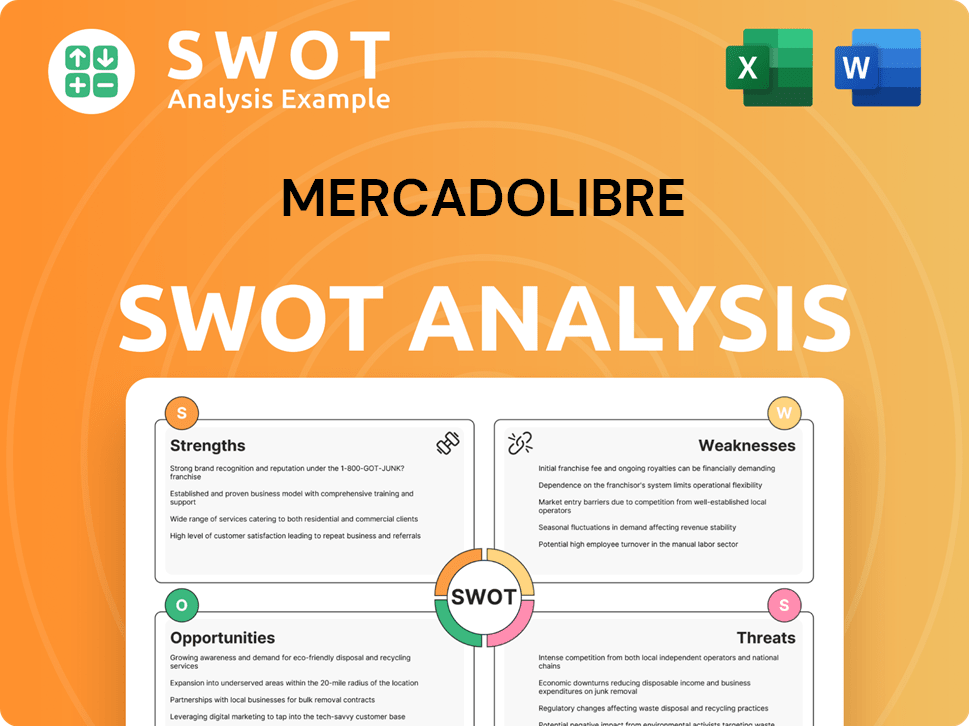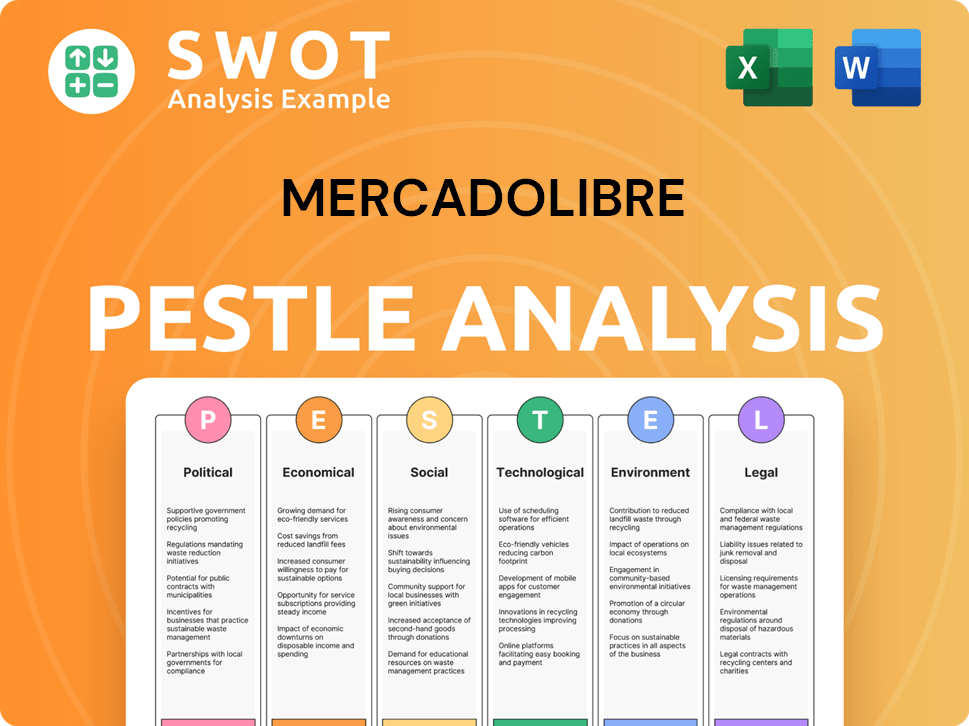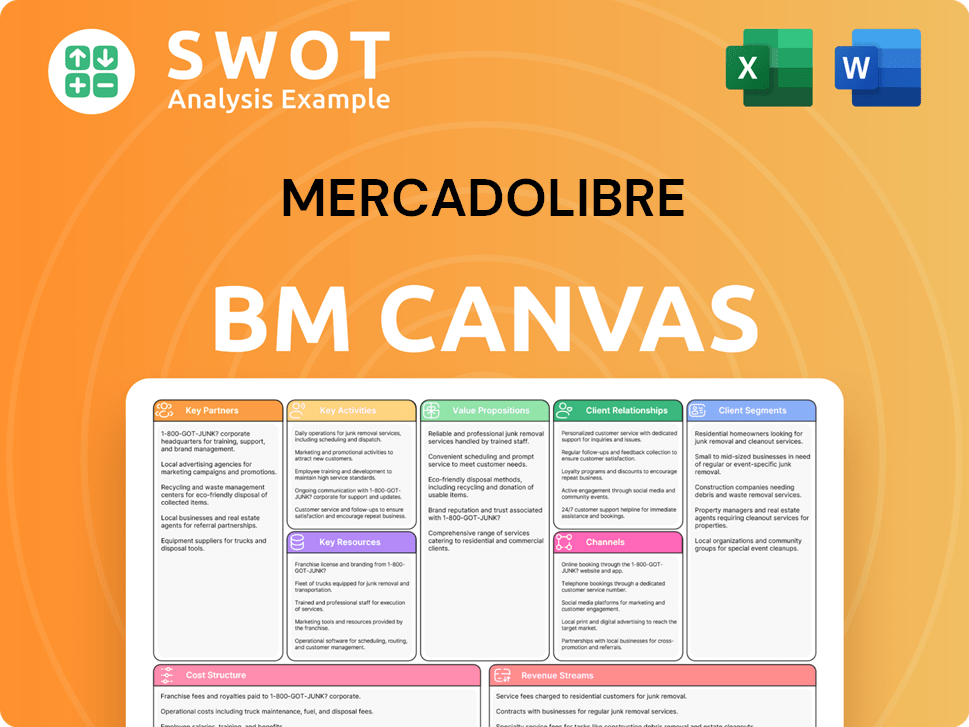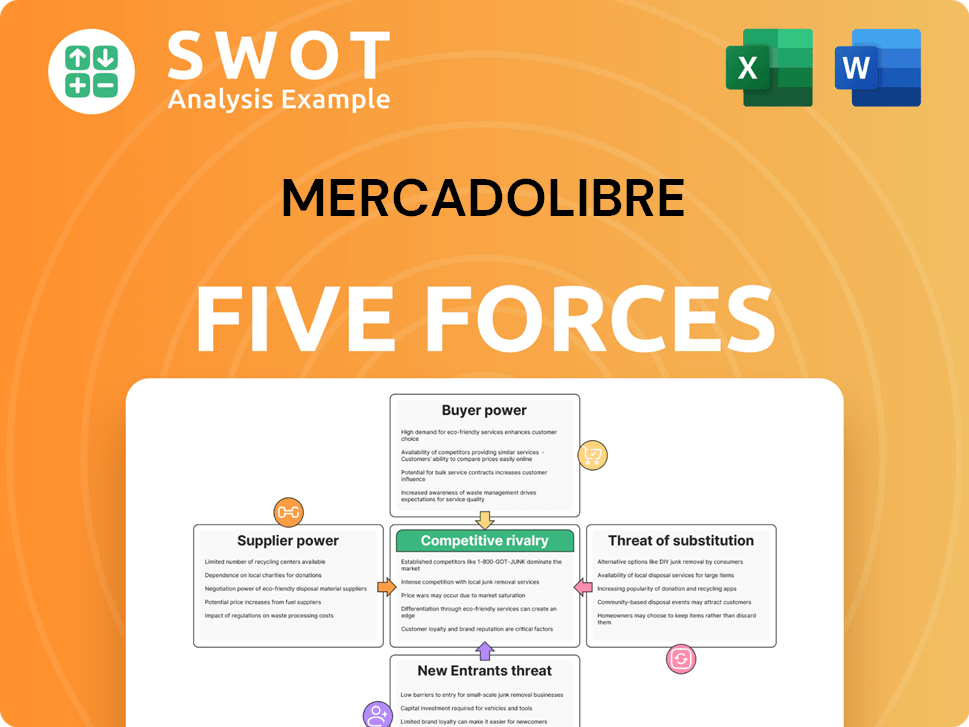MercadoLibre Bundle
How Did MercadoLibre Conquer Latin America?
Witness the remarkable journey of MercadoLibre, the e-commerce titan that has redefined how Latin America shops and pays. From its humble beginnings as an auction site, MercadoLibre has evolved into a multifaceted MercadoLibre SWOT Analysis powerhouse, dominating the e-commerce platform landscape.

This exploration delves into the core of MercadoLibre's success, dissecting its innovative MercadoLibre sales strategy and dynamic MercadoLibre marketing strategy. We'll uncover the secrets behind its robust MercadoLibre business model, examining how it has captured the Latin America market with its compelling online marketplace.
How Does MercadoLibre Reach Its Customers?
The sales channels of the company are primarily centered around its robust online marketplace, which serves as a core e-commerce platform. This platform facilitates transactions between third-party merchants, individual sellers, and the company itself. The company's approach is further enhanced by its fintech arm, which provides secure payment solutions and a wide array of financial services.
The evolution of these channels has involved strategic shifts and significant investments. The introduction of Mercado Pago in 2003 was a pivotal move, addressing the need for reliable payment solutions in a region with lower credit card penetration. The company's focus has been on integrating direct sales and classified advertising to complement its marketplace.
The company's sales and marketing strategy is heavily reliant on its online marketplace and its integrated financial services arm, Mercado Pago. This approach is designed to provide a seamless and secure e-commerce experience. The company continues to invest in its logistics network, Mercado Envios, to ensure efficient delivery across its operational footprint, enhancing its competitive position in the Latin America market.
The company's e-commerce platform is the primary sales channel, connecting millions of buyers and sellers. It offers a wide range of products, from electronics to fashion, and serves as a fully automated marketplace. This strategy is essential for its growth in the Latin America market.
Mercado Pago is a crucial component, facilitating secure transactions and offering various financial services. It provides digital accounts, debit cards, and credit lines. The integration of Mercado Pago has significantly boosted the company's sales strategy.
The company has invested heavily in its logistics network, Mercado Envios, which is crucial for efficient delivery. In 2024, 95% of packages were routed through its proprietary system. This investment supports its growth strategies in Latin America.
The company has formed key partnerships and exclusive distribution deals to enhance its market presence. The expansion of the Mercado Pago alliance with Western Union in 2024 is a good example. These collaborations contribute to the company's international expansion strategy.
In Q3 2024, Mercado Pago had 56 million monthly active users, a 35% year-over-year increase, and accounted for 41% of total sales. Total payment volume reached $197 billion in 2024, up 34% year-over-year. The company's same-day delivery service is available in 30 cities.
- The company opened 10 new fulfillment centers in 2024.
- 49% of orders were delivered within the same or next day in 2024.
- The company has a fleet of over 3,600 electric vehicles.
- The company's sales strategy is supported by its digital marketing channels.
MercadoLibre SWOT Analysis
- Complete SWOT Breakdown
- Fully Customizable
- Editable in Excel & Word
- Professional Formatting
- Investor-Ready Format

What Marketing Tactics Does MercadoLibre Use?
The marketing tactics employed by the company are diverse, integrating both digital and traditional methods to boost brand recognition, generate leads, and drive sales throughout Latin America. This e-commerce platform strategically uses a mix of online and offline strategies to reach its target audience. The company's approach is heavily influenced by data analysis and customer segmentation to enhance user experience and drive sales.
A key component of the company's digital strategy involves leveraging its own platform for advertising. This includes on-platform advertising, which is expected to reach $4 billion by 2028, quadrupling the expected 2024 revenue of $1 billion. The company also focuses on data-driven marketing, using customer data to personalize shopping experiences.
The company's marketing efforts also extend to promoting its fintech services. For example, in the first half of 2024, a study by the company showed a 27% growth in consumers of sustainable products, totaling over 2.7 million buyers. This trend is met by the company expanding its offerings of positive-impact products and promoting sustainable brands through initiatives like the 'Ecoweek Campaign' in August 2024, which offered discounts of up to 40% on such items.
The company's advertising revenue grew 37% year-over-year in Q3 2024, reaching $258 million in sales. This on-platform advertising strategy is expected to reach $4 billion by 2028.
The company uses machine learning algorithms to personalize shopping experiences. This focus has resulted in enhanced brand preference metrics, reaching all-time highs in key markets like Brazil, Mexico, Argentina, and Chile in Q1 2025.
Mercado Pago's monthly active users grew 34% year-over-year to 61 million in Q4 2024. This growth is partly due to competitive yields on deposits and improved services.
A study in the first half of 2024 showed a 27% growth in consumers of sustainable products, totaling over 2.7 million buyers. The 'Ecoweek Campaign' in August 2024 offered discounts of up to 40% on sustainable items.
The company consistently invests in brand positioning and user experience. This suggests a continued, albeit more integrated, approach to reaching consumers across the Latin America market.
The company’s approach to customer acquisition includes a strong focus on digital marketing channels. These efforts are designed to drive sales and build brand awareness within the online marketplace.
The company's marketing strategy is a blend of digital and traditional methods, with a significant emphasis on data-driven insights. The company uses its e-commerce platform to drive advertising revenue and enhance the customer experience.
- Digital Advertising: Leveraging its platform for advertising, with on-platform advertising expected to reach $4 billion by 2028.
- Data-Driven Personalization: Using machine learning to personalize shopping experiences based on user data.
- Fintech Promotion: Marketing its fintech services, such as Mercado Pago, to increase user engagement.
- Sustainability Initiatives: Promoting sustainable products and brands through campaigns like 'Ecoweek'.
- Brand Building: Consistent investment in brand positioning and user experience to reach consumers effectively.
- Customer Acquisition: Employing various digital marketing channels to acquire and retain customers. For more details, you can read about the Growth Strategy of MercadoLibre.
MercadoLibre PESTLE Analysis
- Covers All 6 PESTLE Categories
- No Research Needed – Save Hours of Work
- Built by Experts, Trusted by Consultants
- Instant Download, Ready to Use
- 100% Editable, Fully Customizable

How Is MercadoLibre Positioned in the Market?
The brand positioning of the company centers on its mission to 'democratize commerce and payments in Latin America.' This core message emphasizes accessibility, empowerment, and transformation, aiming to revolutionize how people across Latin America shop, pay, and thrive in the digital economy. The company distinguishes itself through a comprehensive and tightly integrated ecosystem encompassing e-commerce, logistics, digital payments, credit, and advertising services.
This integrated approach, particularly the synergy between its marketplace and Mercado Pago, creates a powerful value proposition that fosters trust and convenience in a region where online transaction trust was historically low. The company's brand identity is consistently maintained across its various channels, from its e-commerce platform to its logistics network and fintech services. This consistency is crucial for building and maintaining consumer trust and loyalty. The company's strong brand equity and user experience have been instrumental in sustaining its growth and market leadership.
The company appeals to its target audience through value, innovation, and a commitment to financial inclusion. Its platform empowers millions of small and medium-sized businesses by providing them with the necessary tools to compete, while also offering a vast array of products to consumers. The brand's visual identity and tone of voice are generally perceived as dynamic and forward-thinking, reflecting its continuous evolution and adaptation to market needs. For more insights into the company's ownership structure, you can explore Owners & Shareholders of MercadoLibre.
The company's brand preference metrics reached all-time highs in key markets like Brazil, Mexico, Argentina, and Chile in Q1 2025. This demonstrates the strength of its brand in the competitive Latin America market.
The company actively responds to shifts in consumer sentiment, such as the growing demand for sustainable products. A study in the first half of 2024 showed a 27% growth in consumers of sustainable products, leading to the expansion of positive-impact product offerings.
The integrated ecosystem, including e-commerce, logistics, and digital payments, creates a powerful value proposition. This approach fosters trust and convenience, crucial in the online marketplace.
The company demonstrates responsiveness by adapting to market needs. For example, the temporary change of its handshake logo to an elbow bump during the 2020 pandemic showed alignment with public health concerns.
MercadoLibre Business Model Canvas
- Complete 9-Block Business Model Canvas
- Effortlessly Communicate Your Business Strategy
- Investor-Ready BMC Format
- 100% Editable and Customizable
- Clear and Structured Layout

What Are MercadoLibre’s Most Notable Campaigns?
The sales and marketing strategy of MercadoLibre, a leading e-commerce platform, is driven by several key campaigns designed to enhance user experience, expand its service offerings, and strengthen its brand presence in the Latin America market. These campaigns are not always traditional, named marketing initiatives, but rather ongoing strategic investments and operational improvements that function as continuous efforts to drive growth. These include initiatives focused on logistics, fintech solutions, and sustainability, all contributing to the company's overall business model success.
MercadoLibre's approach involves a blend of enhancing its core e-commerce platform and diversifying into financial services and logistics. The company leverages digital marketing channels and data analytics to optimize its sales performance. A critical aspect of its marketing strategy is understanding its target audience and tailoring its offerings to meet the specific needs and preferences of consumers in Latin America. This approach allows MercadoLibre to maintain a competitive edge in the online marketplace.
The company's success is also rooted in its ability to adapt to market changes and consumer behavior. By continuously improving its platform, expanding its services, and focusing on customer satisfaction, MercadoLibre has established itself as a dominant player in the region. For a broader understanding, explore the Competitors Landscape of MercadoLibre.
MercadoLibre consistently invests in and promotes its logistics network, Mercado Envios. In 2024, the company opened 10 new fulfillment centers. These investments aim to provide fast and reliable delivery, a core value proposition for attracting and retaining buyers.
Mercado Pago is continuously promoted as a comprehensive fintech solution. In Q4 2024, monthly active users increased by 34% year-over-year to 61 million. Marketing efforts highlight competitive yields and access to credit.
MercadoLibre engages in 'campaigns' related to sustainability and social impact. The 'Ecoweek Campaign' in August 2024 offered discounts on positive-impact products. This initiative aimed to meet consumer demand for sustainable choices and enhance MercadoLibre's reputation as a responsible platform.
MercadoLibre invested $150.8 million towards building one of the largest fleets of electric vehicles in the region (over 3,600 by 2024) and $24.2 million in its 'Regenera América' program for forest restoration. These efforts serve as powerful brand-building campaigns.
Unique buyers surpassed 100 million in 2024, a 24% increase compared to 2023. This demonstrates the effectiveness of the company's strategies in attracting and retaining customers.
Mercado Pago's credit portfolio grew 74% year-over-year to $6.6 billion in Q4 2024, driven by marketing efforts highlighting its financial services. The transformation into a digital bank in Mexico further fueled growth.
95% of shipments were managed within the MercadoLibre network. 49% of deliveries were completed within the same or next day, improving user experience and driving sales.
MercadoLibre Porter's Five Forces Analysis
- Covers All 5 Competitive Forces in Detail
- Structured for Consultants, Students, and Founders
- 100% Editable in Microsoft Word & Excel
- Instant Digital Download – Use Immediately
- Compatible with Mac & PC – Fully Unlocked

Related Blogs
- What are Mission Vision & Core Values of MercadoLibre Company?
- What is Competitive Landscape of MercadoLibre Company?
- What is Growth Strategy and Future Prospects of MercadoLibre Company?
- How Does MercadoLibre Company Work?
- What is Brief History of MercadoLibre Company?
- Who Owns MercadoLibre Company?
- What is Customer Demographics and Target Market of MercadoLibre Company?
Disclaimer
All information, articles, and product details provided on this website are for general informational and educational purposes only. We do not claim any ownership over, nor do we intend to infringe upon, any trademarks, copyrights, logos, brand names, or other intellectual property mentioned or depicted on this site. Such intellectual property remains the property of its respective owners, and any references here are made solely for identification or informational purposes, without implying any affiliation, endorsement, or partnership.
We make no representations or warranties, express or implied, regarding the accuracy, completeness, or suitability of any content or products presented. Nothing on this website should be construed as legal, tax, investment, financial, medical, or other professional advice. In addition, no part of this site—including articles or product references—constitutes a solicitation, recommendation, endorsement, advertisement, or offer to buy or sell any securities, franchises, or other financial instruments, particularly in jurisdictions where such activity would be unlawful.
All content is of a general nature and may not address the specific circumstances of any individual or entity. It is not a substitute for professional advice or services. Any actions you take based on the information provided here are strictly at your own risk. You accept full responsibility for any decisions or outcomes arising from your use of this website and agree to release us from any liability in connection with your use of, or reliance upon, the content or products found herein.